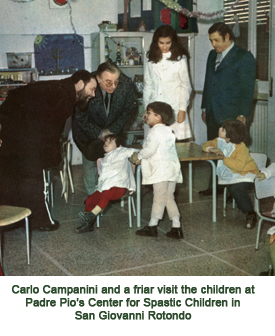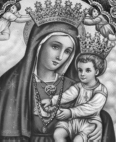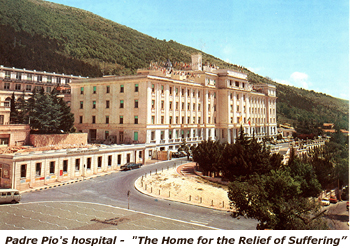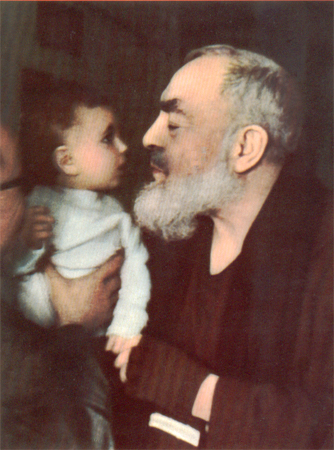I love my spiritual children as much as my own soul and even more.
I have regenerated them through prayer and suffering.
– St. Pio of Pietrelcina
Padre Pio and His Friends from Southern California
A note from the editors: We interviewed each of the three individuals whose testimonials appear in this issue of “Pray, Hope, and Don’t Worry.” They hold in common, a great esteem for their spiritual father, Padre Pio,and a generosity in sharing his message with others. They all currently reside in Southern California.
When Charles Mandina reflects on his life, he feels that it was the Rosary that was initially instrumental in leading him to Padre Pio. After his mother passed away, Charles often found comfort in holding her Rosary. He did not know the prayers of the Rosary but having it with him seemed like a connection to his mother. It was at this time that someone gave him a book on Padre Pio, telling him it was a book he needed to read. He read the book with great interest and not long after he made a trip to San Giovanni Rotondo to see Padre Pio. The year was 1961.
Charles attended Padre Pio’s Mass and was profoundly impressed. When he made another trip to San Giovanni Rotondo, Padre Pio asked him to stay on and assist him with the work. He became Padre Pio’s Italian/English translator, interpreting for the many English speaking pilgrims who came to see Padre Pio. Living inside the monastery he worked at Padre Pio’s side each day. He also assisted as one of his correspondence secretaries.
Charles remembers with a smile that his very first job in San Giovanni Rotondo was cracking almonds in the kitchen of Mary Pyle, Padre Pio’s American secretary. Once Charles told Mary, “I don’t feel like I know Padre Pio. You must know him very well, Mary, since you have been living close to him and assisting him for so many years.” “No, Charles,” Mary said. “I don’t know Padre Pio. Nobody does. Only God knows him.”
One time Mary mentioned to Charles that Padre Pio walked at an angle, as if under the weight of a heavy cross. Charles had noticed it as well. He walked as if supporting a great weight. It was the walk of the Cyrenean, carrying the cross of Christ.
Charles assisted at Padre Pio’s Mass and at the conclusion of the Mass he would take Padre Pio’s arm and help him down from the altar. Holding his arm, Charles could feel the suffering that was present in his body. It was always after the Mass that Charles noticed that Padre Pio walked at an angle.
Once after hearing Charles’ confession, Padre Pio told him to make a pilgrimage to Monte Sant’Angelo and visit the shrine of St. Michael the Archangel. Padre Pio had experienced St. Michael’s protection on many occasions and had gone on pilgrimage to the shrine in 1917. Each year Padre Pio made a preparation of forty days for St. Michael’s feast. “Consecrate yourself to St. Michael and to the angels,” Padre Pio told Charles. “You will need the help of St. Michael, living in this world.”
Charles noticed that when Padre Pio greeted visitors, or while conversing with the friars, or when engaged in other activities, he always kept his left hand hidden inside of his habit. Charles often wondered about this and one day discovered the reason. Padre Pio had a hook sewn inside of his habit and his left hand was holding on to his Rosary that was concealed from view. He was able to meet the many visitors, converse with friends and carry on a busy apostolate while at the same time praying the Rosary.
Charles used to see the doctors from Padre Pio’s hospital, “The Home for the Relief of Suffering,” at the 5:00 am Mass every morning. After the Mass they would often seek advice from Padre Pio on especially difficult medical cases, asking whether it was advisable for certain patients to have surgery or not. Padre Pio never had to spend a long time pondering the questions but responded quickly. He advised the doctors according to the light given to him by God. Those who worked closely with Padre Pio all agreed that when his advice was followed, the outcome always proved to be the most beneficial for all concerned.
Charles remembers Enrico Zeni, a chimney sweep by trade, who came to Mary Pyle asking for a job. Enrico’s face, hands, and clothing were generally always covered with a thick layer of soot and ashes. Mary asked Padre Pio if she should hire Enrico. “Yes, give him a job,” Padre Pio said. “His face may be dirty, but his soul is as white as snow.” Enrico became a very close friend of Padre Pio. It was Enrico who would open the little window in the monastery every evening so that Padre Pio could look out and wave to the large crowd assembled outside waiting to bid him goodnight.
Padre Pio often told jokes, and if he liked a particular joke, he would repeat it on many occasions. “That’s corny,” the friars would say to tease him. “It isn’t corny,” Padre Pio would reply. “It is very funny!”
Charles remembers the time a doctor and an engineer, both from the Philippines, came to the monastery in hopes of meeting Padre Pio. Padre Pio saw the men from a distance and told Charles to tell them to go and put on long sleeve shirts or he would not see them. The two men objected. “It is the middle of summer and very hot,” they said. “We have just come from Rome and have been to the Vatican where everyone is wearing short sleeved shirts.” Although they were indignant, they did as they were told and came back wearing long sleeved shirts.
Charles was present when Padre Pio walked in the room to greet the two men. They immediately fell to their knees and the room became permeated with an intense scent of perfume. The fragrance was so strong that their eyes began to water and their noses began to run. In a blessing, Padre Pio tapped the doctor on his head three times. The doctor was so overcome by the experience and by the great sense of spiritual power that was radiating from Padre Pio that Charles had to take his arm and help him up and to a nearby bench.
Charles describes Padre Pio as a simple man, a humble man whose life revolved around the Blessed Sacrament and the Rosary. Padre Pio would say, “If God had given the gifts he has given me, to another man, he would have made much better use of them.”
Of the many graces Charles received while living and working in San Giovanni Rotondo that which he treasures the most is being present at Padre Pio’s Mass. The impact of his Mass cannot really be explained; it could only be experienced. People who had the good fortune to be present at his Mass were aware that something exceptional was taking place. It is impossible for any one who saw Padre Pio celebrate Mass even once to forget it. The experience was sufficient to produce a profound spiritual change in many people. Charles described Padre Pio’s face at the altar as “shining like the sun.” “He lived the Mass, he lived the crucifixion and the long hours in the confessional these were even more important than the miracles,” Charles said.
Counting the time he lived in the monastery, as well as many subsequent trips to see his spiritual father, Charles spent approximately one year in San Giovanni Rotondo. When he was returning to the United States to live, he asked Padre Pio for direction on the course his life was to take. “I will guide you,” he simply said. Charles helped begin one of the first American Padre Pio Prayer Groups in Los Angeles in 1966. He has also spread devotion to Padre Pio in the Philippines, the Hawaiian Islands, including the leper colony of Molokai, and Mexico. Charles said, “Curiosity might initially bring people to him, but once you had seen Padre Pio, you couldn’t explain it, but you were changed.”
________________________________
Rocco Falatico has received many blessings in his life but the one that will always be uppermost in his mind is the visit he made to San Giovanni Rotondo in 1964 when he was 24 years old and the healing his son received through the intercession of Padre Pio.
Rocco first noticed something amiss with two year-old Rocky when he began having difficulty walking. Tests from the doctor revealed that Rocky had a malignant brain tumor. Surgery was performed but the doctors were not able to remove all of the tumor. When Rocky was brought home from the hospital he was unable to walk and the doctors said there was a possibility that he would never walk again. Even though Rocky received thirty radiation treatments, the doctors could not offer any hope to the family. They estimated that little Rocky’s chance of recovery was one in one hundred thousand.
Charles Mandina worked at the same company with Rocco, and having just come back from San Giovanni Rotondo, his enthusiasm for Padre Pio was contagious. He shared with Rocco many stories about Padre Pio, and Rocco was so impressed that he decided to take his son to San Giovanni Rotondo and make his request to Padre Pio in person. He would ask Padre Pio to pray for his son’s healing. For the first time in many months, Rocco began to have hope.
When Rocco arrived in San Giovanni Rotondo, he entered the monastery church of “Our Lady of Grace” and saw Padre Pio at the altar, leading the afternoon Benediction service. Rocco noticed that Padre Pio’s face had a very noticeable spiritual radiance. He had never witnessed anything like that before.
The next day Rocco was able to greet Padre Pio. Padre Pio put his hand on Rocco’s head in a blessing and Rocco immediately fell to his knees. “It was like being in the presence of Christ,” Rocco said. Face to face with Padre Pio, Rocco was unable to find the words to ask for prayers for his son.
The following day Rocco was allowed to go into the sacristy to see Padre Pio. So great was the sense of God’s presence in Padre Pio, that Rocco felt overwhelmed; he could not speak. It was a replay of the previous day. He had made the long journey from California to San Giovanni Rotondo to ask Padre Pio to pray for his son, but once in his presence, he found himself unable to utter a word.
Rocco wrote his prayer request on a piece of paper and gave it to one of the Capuchins, asking him to deliver it to Padre Pio. The next day Rocco was told that Padre Pio had offered his life at the Mass that morning for the healing of his son. Later, Padre Pio spoke to Rocco through an interpreter and said, “If you want your son to be healed, you must live in the perfect grace of God. You must live your life in complete conformity to God’s will. Your son’s healing depends on this.”
Rocco and his son spent four days in San Giovanni Rotondo. When they returned to California, little Rocky’s health began to improve. He made a complete recovery from the cancer that was diagnosed as terminal and he has enjoyed good health in all the years since.
________________________________
In 1967, Carmelina Maruca and her two children made a trip to Italy to visit relatives. Before returning home to California, Carmelina and her children along with her sister, Antoinetta, and her brother-in-law, Mario, decided to visit San Giovanni Rotondo to attend Padre Pio’s Mass. Antoinetta and Mario lived in Salerno, Italy where Mario had a medical practice. They were all happy to be together as a family and visit Padre Pio’s monastery.
While in San Giovanni Rotondo, Carmelina noticed the great devotion of the pilgrims to Padre Pio, but somehow she felt differently. “Padre Pio is not a saint,” Carmelina said to herself. “He is a priest, yes, but nothing more than that.” She could not believe otherwise. Padre Pio had been ill and so she and her family waited five days before he was able to celebrate Mass. They attended his Mass and afterward were told that he would be giving a blessing when he came out of the sacristy. About fifty people knelt down and waited outside the sacristy. Carmelina knelt down too but after a short time her knees began to hurt. “Why am I kneeling like this,” Carmelina said to herself. “This is not a holy person we are waiting to see. There are many Capuchins at this monastery and he is one among many. He should not be receiving so much notice. These pilgrims have a misguided devotion.” Carmelina rose to a standing position to be more comfortable.
A few moments later, Padre Pio came out of the sacristy. Carmelina remained standing. He placed his hand on each person’s shoulder, in a blessing but when he came to Carmelina, there was no blessing, only a very severe look which made her feel very uneasy. She realized that he knew what she had been thinking about him and she was deeply embarrassed. Her daughter had noticed the frown on Padre Pio’s face as he looked at her mother. “Mother,” she said. “I saw the look on Padre Pio’s face. He is not happy with you. I am going to pray for you.”
That very brief encounter with Padre Pio made a deep impression on Carmelina. Her attitude changed completely. The knowledge that he had read her heart confirmed to her mind his authenticity. Her devotion to him has increased through the years.
Living in Salerno, Mario and Antoinetta were able to travel to San Giovanni occasionally, where Mario received spiritual direction from Padre Pio. Conversations with Padre Pio were always a source of great consolation to him. During one visit, Padre Pio said to Mario, “I see that there is suffering ahead for you, but with prayer, you will be all right. God will assist you.” Not long after, cancer was discovered in Mario’s shoulder. Very extensive surgery was performed which included the amputation of Mario’s arm. He was no longer able to practice as a surgeon and Antoinetta had to seek employment to support the family. Antoinetta passed away at the relatively early age of 55 years, leaving Mario a widower for many years. Remembering Padre Pio’s words, Mario turned to prayer and he received the strength he needed to fully surrender to God and to accept His will in his life.
________________________________
The Padre Pio Prayer Groups
“Prayer is the key that opens the heart of God.” – St. Pio of Pietrelcina
One of the most significant of the many spiritual legacies that Padre Pio left to the world was his establishment of the Prayer Groups. They came about as an answer to Pope Pius XII’s call to the faithful around the world to gather together and pray. Padre Pio realized the great good that would be accomplished through the Prayer Groups and said, “Children, let’s do something. Let’s roll up our sleeves and be among the first to answer this appeal of the Holy Father.”
In the 1950’s Padre Pio gave instructions for the formal establishment of Prayer Groups around the world. Under the direction of a priest, and with the permission of the local bishop, the groups meet regularly for prayer. Most of the groups meet once a month for Mass, Benediction, and the Rosary. In addition, the members pray for the needs of the Church, for the intentions of the Holy Father, and for the clergy. Padre Pio insisted, “You must have a priest who assists you, because only a priest can guarantee union with the Church.” He further said, “In the Prayer Groups, when my children unite together in prayer, Jesus will be in the midst of them; there will also be the Blessed Virgin. I will also be present in spirit and united in prayer.”
Pope Paul VI officially gave Papal approval for the Prayer Groups in 1968, shortly before Padre Pio’s death. It was Padre Pio’s desire that the Prayer Groups have their official registration and headquarters in San Giovanni Rotondo at the hospital which he founded, the Home for the Relief of Suffering. On March 5, 1966, Padre Pio met with his Prayer Groups at the hospital and said:
“The Prayer Groups, now scattered throughout the world and affiliated with the Home for the Relief of Suffering, are the advance guard of this city of charity… Christ himself is present every time the groups gather together for prayer…under the guidance of their pastors and spiritual directors.
It is prayer that unites all good souls, that renews the conscience, sustains the Home for the Relief of Suffering, comforts the suffering, heals the sick, sanctifies the work, inspires the medical assistants, gives moral strength and Christian resignation in human suffering…Pray alot, my children, pray always, without ever tiring, because it is exactly to prayer that I entrust this work, which God has willed and which will remain and prosper, thanks to the help of Divine Providence and the spiritual and charitable contributions of all souls who pray.”
The spiritual significance of the Prayer Groups was further clarified by a grace that was given to one of Padre Pio’s spiritual daughters, Vittoria Ventrella. Vittoria, an elementary school teacher in San Giovanni Rotondo, had a vision in which she saw Heaven, filled with splendor. In the midst was a priest dressed in the richest of sacred vestments with pearls and precious gems. She saw that it was Padre Pio and his face became as dazzling as the sun, from which emanated innumerable rays of light, moving out into infinity. The rays were made up of myriads of small white and red roses.
The next morning Vittoria went to the friary to tell Padre Pio what she had seen. Padre Pio was already in the confessional when she arrived in the church. “Padre, I did not come for confession,” Victoria said. “I know,” Padre Pio replied. “You came to tell me what you saw last night.” “Padre, should I believe it or was it a dream?” Padre Pio answered, “Do you doubt it?” Vittoria asked him,”What did all those luminous rays mean, formed by thousands of white and red roses that radiated out from you and spread in every direction?” Padre Pio said, “The rays symbolize the Prayer Groups which will be founded throughout the entire world. The white roses represent the souls who attempt to live in grace, in love of God and in fraternal charity. The red roses represent the souls who carry the cross of suffering with joy, and united with Jesus and me, collaborate in the conversion of sinners and in the salvation of souls.”
When Padre Pio died in 1968, there were approximately 700 Prayer Groups. Today there are more than 3,000 worldwide.
________________________________
From Our Spiritual Director
Fr. Louis Solcia, CRSP, our spiritual director, asked Bishop Erba, a fellow classmate, to write about his work in the cause of Canonization of Padre Pio. This is a continuation from the last issue.
“. . .To me, the reading of the four volumes of Padre Pio’s letters was a revelation. The letters disclose not only the ascetic heights Padre Pio attained in the spiritual life but also reveal his firmness as a spiritual director, and the depth of his thought, always abundantly nurtured by the word of God.
Padre Pio’s sanctity shone forth when he encountered “the dark night of the soul” in his words, “when all is darkness around me and within me.” His life was an uninterrupted martyrdom, a miracle, a unique example. His witness gives hope to people and helps those who have lost their faith to reclaim it.
There were three factors that convinced me of the authenticity of this man of God:
1. His endurance for half a century in the stifling rhythm of work and sacrifice, all borne with an outstanding faith.
2. His Christian fortitude and deep humility in bearing trials and persecutions without complaint.
3. The evangelistic fruits of his ministry, in particular the founding of the hospital “Home for the Relief of Suffering” and the establishment of the “Prayer Groups” now spread throughout the world.
I wish that all may follow the teaching and example of generous service that our Saint has left us as his legacy.”
Andrea Maria Erba, CRSP
Bishop of Velletri Sengi





 Carlo Campanini took several detours on his journey back to God. When he met his spiritual father, Padre Pio, he began to see the right direction for his life. Padre Pio lead him with wisdom, love and sometimes humor. The following is his story.
Carlo Campanini took several detours on his journey back to God. When he met his spiritual father, Padre Pio, he began to see the right direction for his life. Padre Pio lead him with wisdom, love and sometimes humor. The following is his story. Fr. Louis Solcia, CRSP, our spiritual director, asked Bishop Erba, a fellow classmate, to write about his work in the cause of Canonization of Padre Pio. This is a continuation from the last issue.
Fr. Louis Solcia, CRSP, our spiritual director, asked Bishop Erba, a fellow classmate, to write about his work in the cause of Canonization of Padre Pio. This is a continuation from the last issue. When Padre Pio was sent to the monastery in San Giovanni Rotondo, there was not one hospital in the entire region. The closest hospital was 25 miles away and people had to travel on roads that were nearly impassable, using the most primitive means of transportation. Often the sick would die on their way to the hospital. It was Padre Pio’s great desire to build a hospital in San Giovanni and provide the people with adequate medical care. His dream was realized in 1956 when the hospital which he named “Home for the Relief of Suffering” opened its doors to the public.
When Padre Pio was sent to the monastery in San Giovanni Rotondo, there was not one hospital in the entire region. The closest hospital was 25 miles away and people had to travel on roads that were nearly impassable, using the most primitive means of transportation. Often the sick would die on their way to the hospital. It was Padre Pio’s great desire to build a hospital in San Giovanni and provide the people with adequate medical care. His dream was realized in 1956 when the hospital which he named “Home for the Relief of Suffering” opened its doors to the public. “On December 5, 1976, my second child, Kelly was born in the Mater Hospital in Belfast. She was delivered by cesarean section because it was discovered before her birth, that her heart was beating very rapidly and that she was very distressed.
“On December 5, 1976, my second child, Kelly was born in the Mater Hospital in Belfast. She was delivered by cesarean section because it was discovered before her birth, that her heart was beating very rapidly and that she was very distressed.